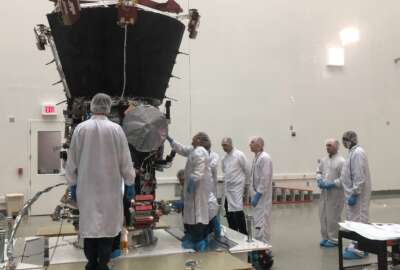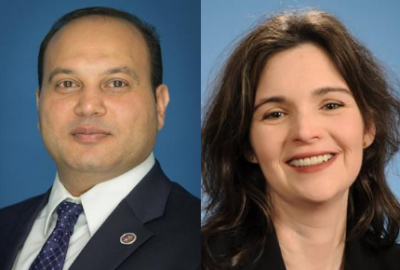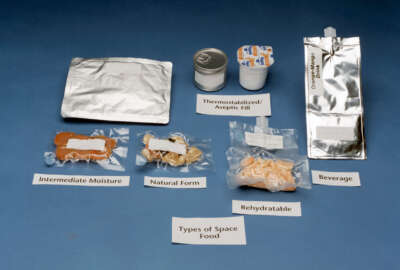An old and large NASA center is about to get an update
NASA's Office of Strategic Infrastructure said yes to a new master plan for Goddard Space Flight Center that cuts building square footage by 25%.
Best listening experience is on Chrome, Firefox or Safari. Subscribe to Federal Drive’s daily audio interviews on Apple Podcasts or PodcastOne.
Goddard Space Flight Center, one of NASA’s original sites, is about to get a major nip and tuck. This after NASA’s Office of Strategic Infrastructure said yes to a new master plan for Goddard. For one thing, Goddard plans to cut its building square footage by 25%. For more details, Goddard’s Associate Center Director Ray Rubilotta joined the Federal Drive with Tom Temin.
Interview transcript:
Tom Temin: Mr. Rubilotta, good to have you on.
Ray Rubilotta: Good morning, Tom, nice to talk to you.
Tom Temin: And just give us a sense of the scope of Goddard. It’s a big facility and it has a lot of satellite facilities, no pun intended. So it’s kind of all over the place.
Ray Rubilotta: Yes, that’s correct. The Goddard Space Flight Center is comprised of six major campuses and they are in the states of Texas, New Mexico, West Virginia, New York City, Maryland, and of course, Virginia. Those, again, are our primary campuses. And then we are a worldwide kind of a setup for NASA, in that we have launch sites all over the world where we conduct our science and our different activities.
Tom Temin: All right, and what does go on there in terms of launches, because it’s called a Space Flight Center?
Ray Rubilotta: Correct. So, quite frankly, Goddard actually starts out with science. Everything we do, we are a science center for NASA. And so what happens is it starts with our science. And we have different operations from cutting technology, to launch support activities. We were intrical, the James Webb Space Telescope, which a lot of news media talked about just last, yesterday, actually was integrated and many components built here at the Goddard Space Flight Center. Our primary campus is here at the Greenbelt, Maryland, facility, where you’re talking about with the launching that actually is out at our Wallops Flight Facility, located in Accomack County in Virginia. And so what we have from there is we have the capability, we actually launched the International Space Station cargo resupplies with our partnership with Northrop Grumman. But we also do a lot of just science work out there. We launch sounding rockets, we have the capability, we manage a balloon program. So the initial technology and science areas of discovery are actually launched from there as well as other sites around the world that Goddard maintains. And then that grows into the larger missions, like a James Webb Space Telescope, as scientists and engineers are able to test those technologies in a safe test range area that we have at Wallops. When you look at our West Virginia, our Katherine Johnson, what we call IV and V, or independent verification and validation facility, that’s where we actually go ahead and we provide an independent look for NASA at all of the software that actually operates on either like, say, science missions, or the Artemis satellite. So we have a select number of missions where we go ahead and do that verification and validation of that code that will be used to make sure that everything operates well.
Tom Temin: Give us a sense of the acreage and the number of people involved here, and then we’ll get into the master plan.
Ray Rubilotta: Sure. So each site has a different footprint. Again, as I mentioned before, our Greenbelt site is the the largest facility we have. And so I would say that we have close to multiple hundreds of thousands of square footage at the Greenbelt campus. We view our footprint not so much in the way of acreage, but is in assets and dollars. So we have over $1 billion of assets. For example, at our Wallops Facility in Virginia, we have 36 major buildings that would cost over $2 billion to replace many of them. Here at the Greenbelt campus, some of our science and engineering and technical facilities. So we have multiple billions of dollars. And so when we look at it, we look at it as a combination of both acreage and square footage and cost of building those facilities.
Tom Temin: And the population?
Ray Rubilotta: We have about a 3,300 civil servant workforce strewn over the six campuses of the Goddard Space Flight Center. And then in totality, we have about a 10,000-person workforce. It’s about 6,700 of our contractor partners that help us support the mission of the Center.
Tom Temin: We’re speaking with Ray Rubilotta, he’s the associate director of NASA’s Goddard Space Flight Center. Let’s get into the master plan, or the newly approved master plan. It looks like you’re going to reduce the building square footage. But first of all, tell us what is the goal of the master plan, in the large sense?
Ray Rubilotta: Sure. So not only for Goddard, but also for all NASA facilities we’ve embarked on making sure that for the NASA of the future that we have the right facilities that will go ahead and be able to efficiently and effectively make sure that we can meet those commitments that the agency has before us. And so the purpose of the master plan is to look at what facilities we have now. See if they have a usefulness into the future? And if not, what new facilities do we need to build? What facilities do we have that with a slight renovation or modification can meet the needs of the future, and then which ones do we just actually need to go ahead and divest ourselves of? And so there is a vision and a plan that the agency has laid forth. And so we’ve worked over the last five years, from a concept plan up to the full approval of our master plan, to go ahead and meet those mission commitments and agency directions to make sure that we have the facilities and the capabilities to go ahead and meet all of those.
Tom Temin: And what will you be doing, then?
Ray Rubilotta: It’s a master plan that actually goes out to about 2037. And so again, this is an agencywide initiative. So we have broken ours out into what I would call five-year phases. What we do is we look at is what we would like to do, as we know today, go ahead and demolish what we would like to renovate, what we would like to divest, where we would like to develop potential partnering or outreach zones at our center, to go ahead and position ourselves so that by the completion of the master plan phase, which is 2037, we have positioned ourselves to be ready to meet the challenges and the needs of the agency.
Tom Temin: And why do you plan to reduce square footage by 25%? That sounds like a lot of buildings to tear down.
Ray Rubilotta: Most of our facilities were built in the ’60s and ’70s, where the layout, the construction, the design of what I would say, current architecture isn’t as readily set up in some of these buildings. They are old in their age. Much of NASA’s infrastructure falls into that area. And so because of that, as we build new buildings, and as we do renovations, we will be able to leverage the technologies of both architecture, as well as needs, as well as what we call within the agency our future of work. If there is a silver lining to the last two years of the pandemic, we have been able to prove as an agency and as a center that working in a hybrid mode, finding the positions not so much of necessarily having people on site but how they can best meet the mission of the agency, whether it be on site or in some other location has afforded us the ability to find buildings that we no longer will need, or that we would have to spend a significant amount of our operations and maintenance budget to maintain, given not only their age, but also the antiquated infrastructure that goes ahead and makes up those facilities. And so we’ve been able to identify buildings that we can go ahead and reduce and take off of our footprint.
Tom Temin: It sounds like you’re expecting a hybrid workforce with respect to on campus and remote or telework pretty much for the foreseeable future?
Ray Rubilotta: Yes. We clearly want to be and continue to be as you know, our employee viewpoint survey scores, NASA 10 years running has been proven to come out to be the best place to work in the federal government. And we want to continue to be that employer of choice for the best and brightest that there are in our nation to help support our advancement in space and in technology and science. And so therefore, yes, we look at how industry is moving. And we have seen that this is something that is not only commonplace in private industry, but starting to make inroads in the federal government. And that’s something that we are looking to embrace and move forward to in the coming years of this hybrid work.
Tom Temin: And earlier you mentioned some of the missions, of course, the space launches to resupply the space station scientific research. You mentioned software review, which sounds like a small mission, but anyone that’s ever touched software knows how much work that takes. Is there any fundamental change in the mission set for Goddard or you’re just realigning to the way they have to be carried out in the future?
Ray Rubilotta: Absolutely, Tom, you’ve got it. It’s the latter. We have verified through this master plan process, that there are nuanced changes to our lines of business as a center, that will be changed going into the future. But the fundamental basis of our lines of business will remain in that of science, balloons, technology, verification of our software, climate change, the environment, all of those areas that we are actively leading today. We will continue to do so into the future.
Tom Temin: And just a detailed question in the science and research area and this is prompted by something I saw which is the emptying of a garage full of oscilloscopes, and other kinds of instruments like that older computers. And at one time oscilloscope was a floor-standing big instrument with a big tube on it. And I asked a friend of mine in electronics, he said, “Nobody uses them anymore. It’s an app on your phone now, everything that an oscilloscope could do.” So I imagine an average laboratory doesn’t need the footage and electrical power. And all of these things that it did decades ago, when people had tube-powered testing gear and that kind of thing.
Ray Rubilotta: You’re absolutely correct. We have just finished building here, for example, at the Greenbelt site recently, within the last 10 years, two new facilities that house our science and our engineering communities. And that’s exactly it. Flexibility is now the key. In previous construction, you built it for a specific purpose. That is no longer the case. All of our technical space is now built with that flexibility and the ability to adjust to new emerging technologies, new requirements. And so that’s where there’s a huge partnership with our science and engineering community, as well as our facilities engineers, to make sure that we are building that capacity into all of our new construction.
Tom Temin: And by the way, getting to a more topical issue. What is the status of Goddard with respect to those that want to come back into the buildings to work? Where do you stand at this point?
Ray Rubilotta: Sure. So we have a saying in NASA, it’s “People first, mission always.” And that’s really the fundamental guidelines that we’re having these conversations right now. So we are having not only our supervisors talk with our missions, and our customers as to what their requirements are, but then we’re also doing the conversation with their staffs to see how we can best then meet those needs. There’s no cookie-cutter approach. There’s no one size fits all. It’s going to be based on the mission, but also taking into account the great benefits that we’ve been able to realize from this hybrid workforce and experience. And then just bringing that on into our future way of working going forward.
Tom Temin: And finally, you said the plan goes to 2037, you won’t be around probably that is to say, working at NASA, we hope you’re still around, but you won’t be at NASA by then will you?
Ray Rubilotta: No, you’ve hit the nail on the head, Tom. I hope I’m not a part of the environment by 2037. But yes, so many master plans, that’s what it does. This is not the first time for Goddard that we’ve had a master plan. In fact, I inherited a master plan from my predecessors that was done, actually in the ’90s. And so what it does is it lays a blueprint of leadership and agency priorities at that time of how the center was going, and then it allows you the ability to modify or adjust that. So even though I personally won’t be here in 2037, working for NASA, whoever replaces me, it will provide that blueprint so they’re not starting from scratch as to what the philosophy, the thoughts were behind how the center needs to position itself to be viable going in for future decades.
Tom Temin: Ray Rubilotta is associate director of NASA’s Goddard Space Flight Center. Thanks so much for joining me.
Ray Rubilotta: Thank you, Tom. It’s a pleasure talking to you.
Copyright © 2025 Federal News Network. All rights reserved. This website is not intended for users located within the European Economic Area.
Tom Temin is host of the Federal Drive and has been providing insight on federal technology and management issues for more than 30 years.
Follow @tteminWFED






